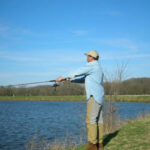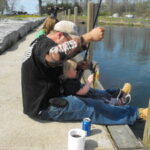I am a woman who loves to fish. I wasn’t born with a pole in my hand, but I grew up in a small town where there was nothing but a lake and a post office. You do the math!
I fish as often as possible, but I do not claim to know everything. In fact, I am always learning new things about fishing and I love that. Previous articles I have published, that may be of interest to you (my dear reader) include Enjoy Fishing Without Risking Your Feminity, Advice for Women Who Want To Fish, and 7 Ways to Have Even More Fun Fishing!
Fishing and hunting are two things often considered a man’s sport. Many women who fish often depend on the man to set up their poles, bait their hook, and take off their fish. As references in Advice for Women Who Want to Fish this is awful. If you are going to drive a car, you should know how to pump your own gas. If you are going to fish, you should know how to do it all yourself.
My first lesson to offer those women who truly do want to fish, and learn how to do it, is to set up your own pole. Once you own your own bait and tackle, you should have all the equipment and should know how to use it!
No matter what you are fishing with, you first want to thread the line through your pole. In my opinion, open reeled poles are the best, but many women prefer closed reels. (Closed reels you push a button, open reels you flip a bar over your line.) Once the line is threaded through all of the holes, you can start by choosing what you are fishing for and what you will use.
Let’s say you want to tight-line fish and you want to increase your chances of catching a fish by using more than one hook. First, you want to tie some sinkers onto the bottom of your line. Do not confuse your sinkers with your split shots!
If you are fishing in a river or lake and you want to cast out into deeper water so you should use one or two sinkers at the end of your line. Here is where most women run into their first obstacle… the knot.
Once mastered, the knot is in fact very easy to do. Thread your line through the hole in the sinker and bring the end of the line back around and by the rest of the line. Wrap the line around but not through yet. In fact, you want to wrap it around a few times, 5 or more, and then pull it through the hole just like a regular knot. This is much easier than trying to tie a double knot, a triple knot, or more. Pull it tight and it will look almost like a noose, although this is not how you tie a noose.
Now that the weights are on, you want to add your hooks. If you like, you can add your hooks before the sinkers… it really doesn’t matter. I prefer to tie the sinkers on so I can get a better idea of the distance between where the hook (and bait) will sit and where the sinkers are. Remember the sinkers will most likely be sitting at the bottom of the water… that’s what they’re meant to do… so you will want at least a few inches between the sinkers and your bottom hook.
Most hooks come tied to a line with a loop at the end. If you alread have your sinkers tied onto the end of your fishing line, you can easily pull an earea of line through the loop, wrap one end of the fishing line around (the loop you have creeated) a few times and then pull the hook through. You should now have the hook securely tied onto your line as well, and you can repeat with as many hooks as you like. Don’t overdo it!
I prefer to use blood bait or minnows on the bottom hook for catfish and a worm on the upper hook for anything that bites. I catch a lot of bass and perch with this method!
/to bait a worm onto a hook, pull a worm out of the container and push the hook through one end. Wrap the worm around, stab the hook through another section, wrap the worm around, and continue this process until the hook is covered with a worm. There may be worm remaining and you will need to pinch the worm apart. Put the rest of the worm back into the container. It’s pretty cool how they live like that… but it’s pretty gross how they deficate on you while you are doing this. So, some women prefer to use gloves for this process.
The more you set up your own pole, the easier it gets. It feels more natural and you should be doing it quickly. If you are not tightline fishing, you can also follow the same knotting technique and throw a spinner or other lure onto the end of your pole for a more active type of fishing.
Or, for a happy medium you can tie a hook onto the end of your pole, stick a couple split shots above your hook and cast. The split shots are those little tiny silver balls that weight your line down but do not make it sink all the way to the bottom. To attach these, and remove them, is so easy it’s ridiculous. There is a little notch in split shots where you insert your line, and then pinch it shut. They will stay on for you, and when you want to taken them off there are two little tabs on the side that will open the split shot back up when you pinch them together.
The split shot line works well with a worm for bass, sunfish and bluegills and you can either drop the line in front of you and watch the fish or you can attach a bobber. The bobbers are also easy to put on and remove. There is a button on bobbers that will push out a hook. You simply put your line through that hook and then release the button. You may need to wrap the line around to the other side of the bobber and repeat… but your bobber will be held in place and float on top of the water. When you have a bite, the bobber will be pulled underwater.
The second thing you should know is what to do when you get a bite. If you are tightline fishing, you will know you have a bite because your pole will jerk. As mentioned, if you have a bobber on the bobber will be pulled down with a bite and if you are using a lure you will feel the bite.
This is where you have to catch the fish! In order to do this you have to jerk the pole back when the fish is biting. Do not do this after you have seen a bite, or you will most likely lose your fish. They will bite again, and timing is key in setting the hook. Once you have jerked your pole back roughly simultaneous to a bite (also called a hit) you want to keep your pole up and your line tight as you are reeling the fish in.
This part can be confusing because larger fish may need to be ”fought with’. You may need to let them struggle and wear themselves out, reeling in and then pausing to let them swim a little before reeling them in more. Those bigger fish are more fun, and more challenging to catch. However, on a regular fishing trip you will most likely catch smaller fish and if you stop reeling you may give them a chance to spit the hook and escape. So keep your line tight and bring your fish in.
The next step is removal of the fish. Again, most women are scared of this. My oldest stepdaughter is terrified of the spikes on their backs… since the most common fish caught (in New York at least) are bass, perch, and bluegills. All of these fish do have spikes on their backs and they will get you if you don’t smooth those spikes down.
Therefore… do not be afraid of the fish. It’s a lot harder if you are being jumpy or nervous about it. If it helps, bring some gloves. Starting at the head of the fish, you want to use your fingers to smooth those spikes down. You may get stabbed in the process, but it really is not that painful. These fish are much easier to remove than bull head and catfish or pike.
Keeping a good grip on the fish, you want to remove the hook. Often enough the hook is just caught through their lip, in which case you want to quickly ‘turn’ the hook and remove it. If you are catching and releasing then this fish will have increased chances of surviving. Unfortunately, some fish are more difficult. For some women it helps to have a pair of pliers to remove the hook. If a fish swallows the hook then it is less likely they will survive and you have to yank the hook out. Pliers do help. In any case, you want to remove the hook as quickly as possible but it will be easy to figure out what needs to be done once you have a good grip on the fish.
As I mentioned catfish and bullhead as well as pike are more difficult. The reason for this is that catfish and bullhead both have ‘whiskers’ on the side that sting you. There is a special way of holding these fish… but I reccommend just cutting the line and counting your loss on the bait. For me at least it is much easier and if these fish are the right size; I plan on taking them home to eat or at least giving them to other fishers instead of releasing them.
The same thing goes for pike. Pike have mouths full of razor sharp teeth. Don’t feel bad about being afraid of these. Men don’t want to stick their fingers in those mouths either! Sometimes is is easier and more logical just to cut the line. However that should not be done for an easier fish like a bass or a perch!
When you’re all done fishing, you just have to take your pole apart. You can either keep the hooks on or take everything off and reel the line in all the way.
It makes it easier for set up next time you fish to leave the hooks on. Simply seperate the top and bottom half of your pole, stick the hooks onto those holes on your pole (what you thread your line through) and reel the line in as tight as you can without snapping the line. If you have sinkers on, wrap the bottom of your line around both pieces of the pole to keep everything together and stored in your trunk.
If you take everything down, a knife works well to cut the part of the line you need to cut, but if you are a smoke using your cigarette works great and keeps the ends intact for set up next time.







